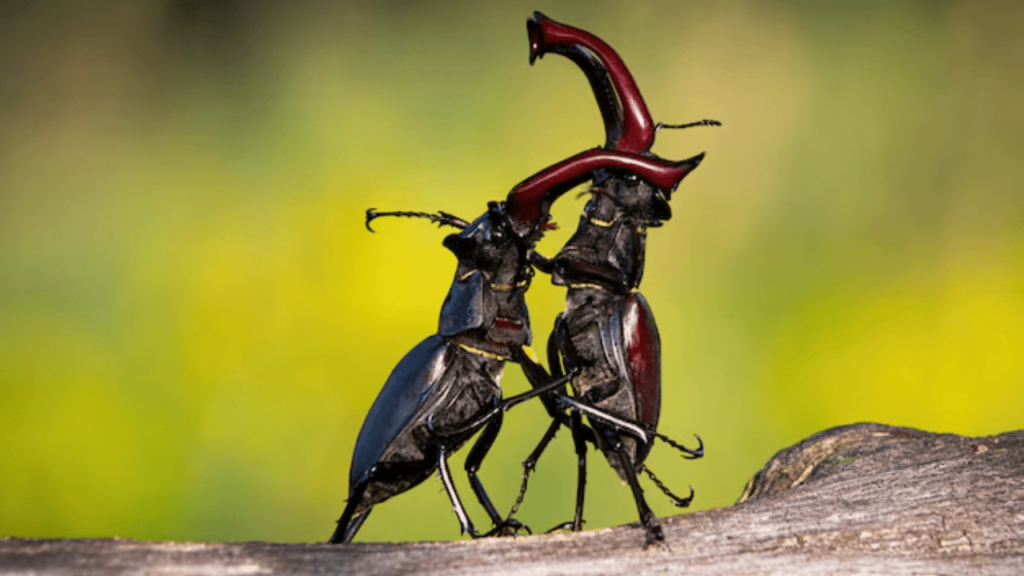The stag beetle’s status as one of the world’s most expensive insects is a testament to its unique blend of rarity, cultural significance, and ecological importance.

In the fascinating world of rare and exotic insects, the stag beetle stands out as one of the most valuable, commanding astonishing prices that can soar up to Rs. 75 lakh. This incredible valuation is not merely due to the insect’s rarity but also its symbolic significance and unique characteristics.
The Value of Rarity
Stag beetles are highly prized for their rarity. These stag beetles thrive in warm, tropical climates and are predominantly found in woodlands, hedgerows, traditional orchards, and even urban parks and gardens where dead wood is abundant. Their sensitivity to cold temperatures restricts their distribution, contributing to their rarity. This limited availability makes them highly coveted among collectors and enthusiasts, driving up their market value significantly.
Symbol of Good Fortune
In addition to their rarity, stag beetles are also considered symbols of good luck in various cultures. Some believe that owning a stag beetle can bring sudden wealth, a notion that has significantly boosted their demand and price. This cultural belief, combined with their physical rarity, has positioned the stag beetle as a luxury item, much like precious gems or rare art pieces.
Unique Physical Traits
Stag beetles are easily recognizable due to their distinctive physical features, particularly the males’ enlarged mandibles, which resemble a stag’s antlers. These mandibles are used during mating competitions, adding to the beetle’s unique appeal.
According to the Natural History Museum in London, male stag beetles measure between 35-75 mm in length, while females range from 30-50 mm. They typically weigh between 2 and 6 grams and have a lifespan of 3 to 7 years. These characteristics make them fascinating subjects for entomologists and collectors alike.
Ecological Importance
Beyond their market value and cultural significance, stag beetles play a crucial role in their ecosystems. A study published in the Scientific Data journal describes stag beetles as a “significant saproxylic assemblage in forest ecosystems.” This means they contribute to the decomposition of dead wood, aiding in nutrient cycling and forest health.
The larvae feed exclusively on dead wood, using their sharp jaws to extract splinters, which helps break down the wood and recycle nutrients back into the soil. This ecological role underscores their importance beyond their economic and cultural value.
Diet and Feeding Habits
Stag beetles have specific dietary preferences that further add to their uniqueness. Adult stag beetles primarily consume sweet liquids, such as tree sap and juice from rotting fruit. They rely heavily on the energy reserves they built up during their larval stage to sustain them through their adult life. This reliance on specific food sources, combined with their habitat requirements, makes their conservation crucial for maintaining their populations.

Medicinal Uses
While specific details on the medicinal uses of stag beetles are scarce, their inclusion in traditional medicine practices adds another layer to their value. The belief in their medicinal properties further elevates their status among rare insects, making them even more desirable.
Conservation Concerns
Despite their high market value, stag beetles face significant threats from habitat loss and environmental changes. Deforestation and urbanization reduce the availability of dead wood, which is essential for their larval development. Conservation efforts are vital to protect these unique insects and preserve their ecological roles. Efforts to maintain and restore their natural habitats are crucial to ensuring their survival and continued presence in their ecosystems.
The Market for Stag Beetles
The high demand for stag beetles has led to a thriving market, particularly in regions where they are considered symbols of good luck. Collectors and enthusiasts are willing to pay premium prices for these insects, often sourced through specialized dealers and breeders. This market dynamic is driven by the beetles’ rarity, cultural significance, and unique physical traits, making them highly sought after in the world of exotic pets and collectibles.
Cultural Significance
The cultural beliefs surrounding stag beetles play a significant role in their high valuation. In some cultures, they are seen as harbingers of good fortune and prosperity. This symbolic significance is deeply ingrained, with historical references and folklore often attributing magical properties to these insects. The belief that owning a stag beetle can bring wealth and success adds a mystical allure, further increasing their desirability and market price.
The Role of Collectors
Collectors of rare insects play a pivotal role in the market for stag beetles. These enthusiasts often seek out the most unique and well-preserved specimens, driving up prices through competitive bidding and exclusive purchases. The prestige associated with owning such a rare and valuable insect adds to the stag beetle’s allure, making it a prized possession among collectors.
Conclusion
The stag beetle’s status as one of the world’s most expensive insects is a testament to its unique blend of rarity, cultural significance, and ecological importance. Valued at up to Rs. 75 lakh, these remarkable beetles are more than just insects; they are symbols of good fortune, ecological marvels, and highly coveted collectibles.
As we continue to learn more about their roles in forest ecosystems and the cultural beliefs that surround them, the fascination with stag beetles is likely to grow, further cementing their place in the world of rare and exotic insects.
Read Next:

The Psychology of Love: Why Valentines Day Matters More Epic Than You Think
Discover the psychology of love and why Valentines Day is more important than you think. Learn how love impacts the brain, strengthens relationships, and boosts

Premier League Highlights: Arsenal Humiliate Man City 5-1, Spurs and Palace Secure Crucial Wins
Arsenal demolished Manchester City 5-1 in a statement premier league highlights win, reigniting their title hopes. Meanwhile, Crystal Palace stunned Man United 2-0, and Tottenham

How Budget 2025 Impacts the Indian Middle-Class: Major Tax Benefits and Glaring Omissions
Budget 2025 offers major tax relief to the middle class, including zero tax on incomes up to ₹12 lakh. However, it misses out on incentives

Degrees vs Employability: Why “Highly Qualified Degree Holders” Struggle to Find Jobs While “Less Qualified Individuals” Get Hired Faster!
Many highly qualified individuals struggle to secure jobs, while less qualified candidates get hired quickly. This Degrees vs Employability paradox is caused by employer preferences,

The Power of Mindset: Why Looking Poor Doesn’t Make You Poor, but Thinking Poor Does!
Discover why looking poor doesn’t define your wealth but thinking poor does. Learn the power of mindset and how a growth-oriented mindset can lead to

Overthinking: How It’s Damaging Today’s Youth – Causes and Cure in 2025
Understanding how overthinking is silently damaging today’s youth, from its causes rooted in societal pressure and social media to its long-term effects on mental health.
